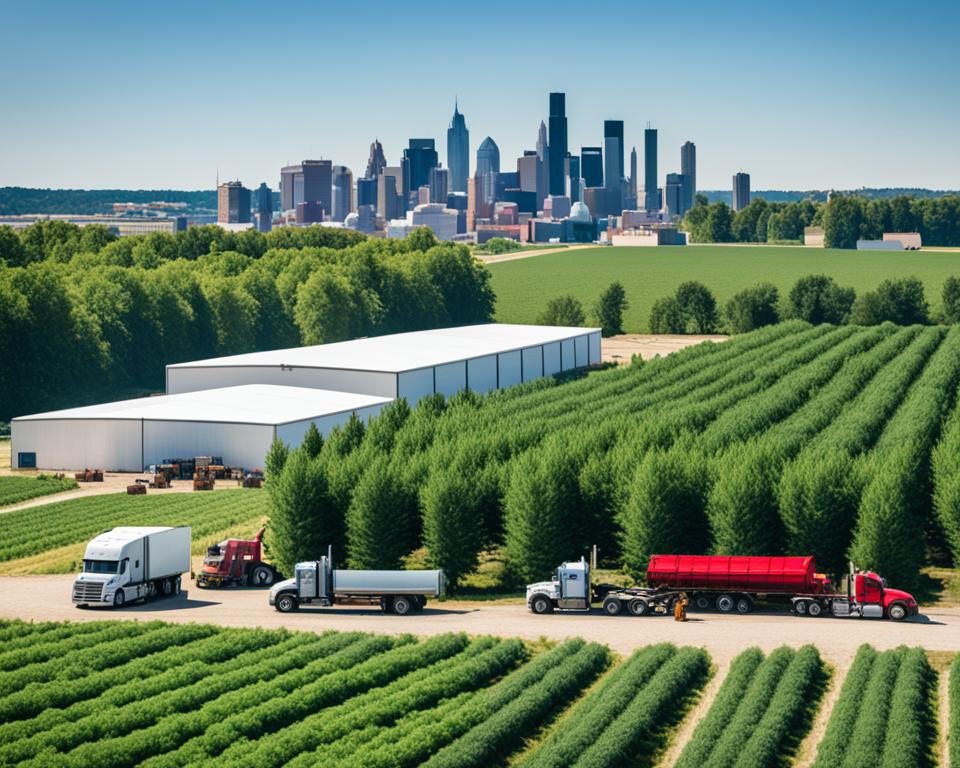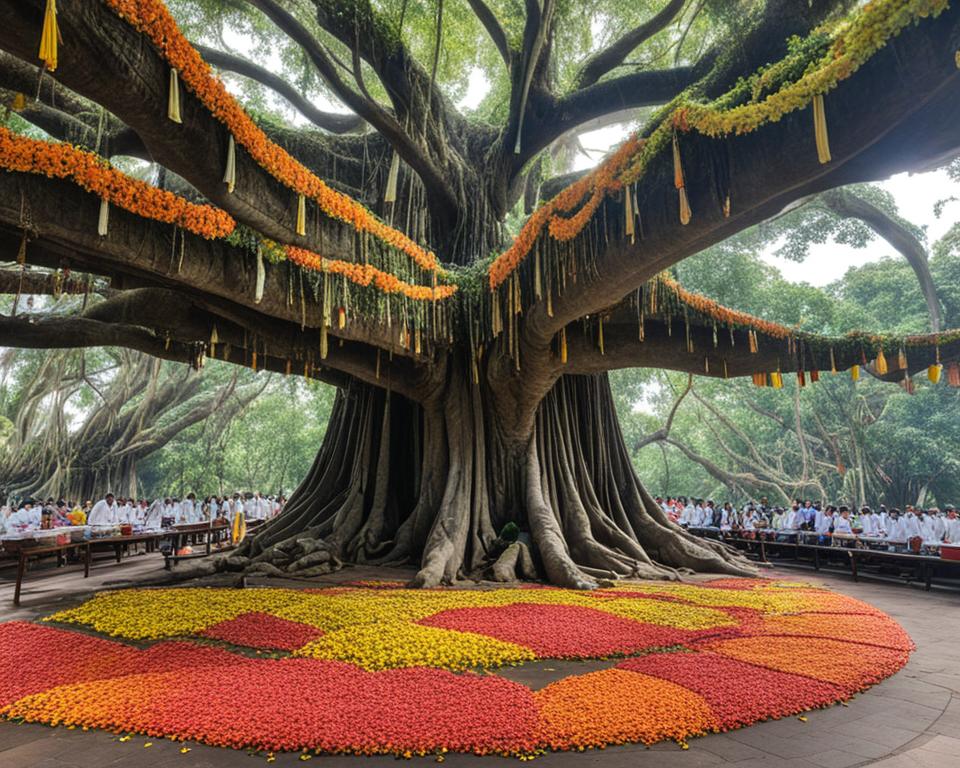Welcome to our article exploring the various uses of trees and their essential impact on the environment, health, and society. Trees are not just beautiful and majestic beings; they provide numerous benefits that are vital for our world and the well-being of all living things. Let’s dive into the incredible uses of trees and discover why they are so essential.
Key Takeaways:
- Trees have a significant impact on the environment, health, and society.
- They act as natural air purifiers, absorb carbon dioxide, and release oxygen through photosynthesis.
- Trees provide shade, reduce the risk of sunburn, and improve air quality.
- They contribute to the economy through timber production, food consumption, and tourism.
- Trees play a crucial role in food production, renewable energy, and wildlife conservation.
Environmental Benefits of Trees

Trees are not only beautiful and majestic, but they also play a crucial role in maintaining a healthy and balanced environment. From the air we breathe to the preservation of wildlife habitats, trees provide a wide range of environmental benefits that are essential for sustaining life on Earth.
One of the most significant environmental benefits of trees is their ability to act as natural air purifiers. Through the process of photosynthesis, trees absorb carbon dioxide, a greenhouse gas that contributes to climate change, and release oxygen. This natural cycle helps to mitigate the effects of climate change, improve air quality, and create a more sustainable ecosystem.
In addition to their role in reducing carbon dioxide levels, trees also help regulate temperatures in their surroundings. The shade provided by tree canopies reduces the amount of heat absorbed by the ground, lowering urban temperatures and mitigating the urban heat island effect. This is particularly important in urban areas, where the abundance of concrete and asphalt can trap heat and lead to higher overall temperatures.
Trees also act as natural water filters and prevent soil erosion. The roots of trees help to bind the soil together, reducing the risk of erosion caused by wind and water. This is especially crucial in areas prone to heavy rainfall or where slopes are vulnerable to landslides. The presence of trees along riverbanks and lakeshores also helps to stabilize the soil, preventing sedimentation and improving water quality.
Beyond their role in climate regulation and water conservation, trees provide essential habitats for countless species of wildlife. The branches, leaves, and trunks of trees offer shelter, nesting sites, and food sources for a wide range of animals, from birds and squirrels to insects and small mammals. By preserving and protecting these habitats, trees contribute to the overall biodiversity and balance of ecosystems.
Trees are like the lungs of the Earth, purifying the air we breathe and creating a healthier environment for all living beings.
In summary, the importance of trees in the environment cannot be overstated. They not only provide aesthetic beauty but also serve as the foundation of a sustainable ecosystem. From their ability to absorb carbon dioxide and release oxygen to their role in regulating temperatures, preventing soil erosion, and providing habitats, trees are truly a lifeline for our planet.
| Environmental Benefits of Trees | |
|---|---|
| 1. Natural air purification | Trees absorb carbon dioxide and release oxygen through photosynthesis, helping to mitigate climate change and improve air quality. |
| 2. Temperature regulation | Trees provide shade and reduce urban temperatures, mitigating the urban heat island effect. |
| 3. Soil erosion prevention | Tree roots help bind the soil together, reducing the risk of erosion caused by wind and water. |
| 4. Habitat creation | Trees provide essential habitats for wildlife, contributing to overall biodiversity and ecosystem balance. |
| 5. Water quality improvement | Trees act as natural water filters, preventing sedimentation and enhancing water quality. |
Health Benefits of Trees

Being around trees has numerous positive effects on our overall health and well-being. Trees not only enhance the beauty of our surroundings but also provide valuable health benefits that contribute to our physical and mental well-being.
Shade for Sun Protection
One of the essential health benefits of trees is providing shade, which reduces the risk of sunburn and skin cancer. By acting as natural umbrellas, trees offer protection from harmful UV radiation, allowing us to enjoy the outdoors while minimizing sun-related health issues.
Improving Air Quality
Trees play a crucial role in improving air quality by filtering pollutants and reducing respiratory problems. Through a process called photosynthesis, trees absorb carbon dioxide and release oxygen, acting as natural air purifiers.
“Trees are the lungs of the Earth, cleansing the air we breathe and providing us with fresh, oxygen-rich air.”
By removing harmful pollutants such as nitrogen dioxide, ozone, and particulate matter, trees contribute to a healthier environment and help prevent respiratory issues such as asthma and allergies.
Stress Reduction and Mental Health
Studies have shown that spending time in natural surroundings with trees has a positive impact on our mental health and well-being. Being in green spaces with trees has been found to reduce stress levels, improve mood, and enhance cognitive function.
The soothing presence of trees is known to promote relaxation, calmness, and a sense of tranquility. Whether it’s taking a walk in a forest or simply sitting under a shady tree, the serenity of nature can rejuvenate our minds and improve our overall mental well-being.
Appreciating the health benefits of trees reminds us of the importance of preserving and nurturing our natural environment. By protecting and planting trees, we can ensure a healthier future for ourselves and generations to come.
Economic Benefits of Trees

Trees are not only vital for the environment and our well-being, but they also have significant economic importance. Their contributions to various sectors help generate income and promote financial stability. Let’s explore the economic benefits of trees and how they contribute to the growth of industries.
Timber for Construction
One of the primary economic benefits of trees is their role in providing timber for construction purposes. As a renewable resource, trees are harvested sustainably to meet the demand for building materials. The timber industry employs thousands of workers worldwide and contributes to the growth of the construction sector.
Raw Materials for Paper Production
Trees also serve as a valuable source of raw materials for paper production. The pulp and paper industry heavily rely on trees to produce various paper products, such as newspapers, books, and packaging materials. This industry generates significant revenue and creates employment opportunities for many individuals.
Fruits and Nuts for Food Consumption
In addition to timber and raw materials, trees offer a bounty of fruits and nuts for food consumption. Fruit orchards and nut farms are essential for the agricultural sector, providing a diverse range of nutritional options. The income generated from the sale of fruits and nuts enhances food security and supports local economies.
Enhancement of Property Values
Trees significantly contribute to enhancing property values. Research has shown that houses surrounded by trees and well-maintained green spaces tend to have higher market prices. Trees improve the aesthetic appeal of properties and create a sense of tranquility, attracting potential buyers and increasing financial value.
Promotion of Tourism
Areas known for their scenic beauty, which often includes lush forests and tree-covered landscapes, attract tourists from around the world. The presence of trees promotes tourism, leading to economic growth in those regions. Nature-based tourism, such as hiking, wildlife spotting, and eco-tourism, relies on the beauty and serenity provided by trees.
Investing in tree planting initiatives and sustainable forestry practices not only benefits the environment but also generates economic opportunities for communities and industries.
In conclusion, trees offer not only environmental and health benefits but also significant economic advantages. Their contributions to the timber industry, paper production, food consumption, property values, and tourism play a vital role in income generation and financial stability. It is crucial to recognize and appreciate the economic value of trees while ensuring their sustainable management for future generations.
| Economic Benefits | Examples |
|---|---|
| Timber Industry | Construction materials |
| Pulp and Paper Industry | Newspapers, books, packaging |
| Agricultural Sector | Fruits, nuts |
| Property Values | Higher market prices |
| Tourism | Nature-based tourism |
Trees for Food Production

In addition to their environmental and health benefits, trees also play a crucial role in food production. Many trees bear fruits, nuts, or other edible parts, making them valuable resources for creating sustainable and diverse agricultural practices.
Fruit trees are a staple in food production, providing an abundance of nutritious and delicious fruits. Apples, oranges, peaches, and cherries are just a few examples of fruit trees that are widely cultivated for their culinary and health benefits. These trees not only offer a source of vitamins and minerals but also contribute to the flavor and variety of our diets.
| Fruit Tree | Fruit | Health Benefits |
|---|---|---|
| Apple Tree | Apples | Rich in fiber and antioxidants |
| Orange Tree | Oranges | High in vitamin C and antioxidants |
| Peach Tree | Peaches | Low in calories and a good source of vitamins A and C |
| Cherry Tree | Cherries | Contains antioxidants and anti-inflammatory compounds |
Nut trees also contribute significantly to food production. Walnuts, almonds, pecans, and hazelnuts are popular examples of nut trees that provide a rich source of protein, healthy fats, and essential nutrients. These trees not only offer culinary versatility but also support sustainable farming practices and offer economic opportunities.
“Fruit and nut trees not only provide nutrition but are essential for sustainable and diverse agricultural practices,” notes Dr. Jane Brown, a renowned agricultural scientist.
In addition to traditional fruit and nut trees, various tree species bear edible parts that can be used for culinary purposes. These include trees like moringa, a nutrient-dense tree known for its leaves, and avocado, which provides a creamy and nutritious fruit. Exploring the potential of edible tree species can lead to innovative food production methods and contribute to global food security.
By incorporating trees for food production, we can not only nourish ourselves but also promote sustainable agricultural practices and enhance food diversity. Tree-based food production provides a multitude of benefits, encompassing nutrition, economic opportunities, and environmental conservation.
Trees for Renewable Energy

Trees play a crucial role not only in sustaining our environment but also in providing renewable sources of energy. One of the key ways trees contribute to renewable energy production is through wood biomass obtained from sustainably managed forests.
Wood biomass refers to the organic matter derived from trees, such as branches, wood pellets, bark, and sawdust. This biomass can be utilized to generate various forms of renewable energy, including bioenergy and tree-based fuels.
Bioenergy, also known as biofuel, is energy derived from organic matter, which includes wood biomass. It is an environmentally friendly alternative to fossil fuels as it reduces greenhouse gas emissions and contributes to mitigating climate change.
Tree-based fuels, such as wood pellets and wood chips, are produced from compressed or chipped wood biomass. These fuels can be burned in specialized biomass power plants to generate electricity and heat. They are considered carbon-neutral as the carbon dioxide released during combustion is offset by the carbon absorbed by the growing trees.
The use of trees for renewable energy offers significant benefits. It helps reduce dependence on fossil fuels, decreasing greenhouse gas emissions and mitigating climate change. Additionally, utilizing wood biomass contributes to sustainable forestry practices, as it encourages the growth and management of trees in well-regulated forests.
Image:
The following table highlights the advantages and challenges associated with using trees for renewable energy:
| Advantages | Challenges |
|---|---|
| – Renewable and sustainable energy source | – Need for proper forest management and conservation to ensure sustainable biomass production |
| – Reduction in greenhouse gas emissions | – Potential competition with other land uses for biomass production |
| – Contribution to rural economies through biomass industry | – Proper assessment of carbon cycles and sustainability criteria |
Source: Own compilation
In conclusion, trees not only provide valuable environmental and social benefits but also serve as a source of renewable energy. By harnessing wood biomass, we can reduce our reliance on fossil fuels, mitigate climate change, and promote sustainable forest management. Trees truly are a remarkable resource that supports both the present and future generations.
Trees for Urban Landscaping and Aesthetics

Trees play a significant role in enhancing the beauty and aesthetics of urban landscapes. They bring life to concrete jungles, creating a more visually appealing environment for residents and visitors alike. The importance of trees in cities goes beyond their ornamental value, as they provide a host of benefits that contribute to the overall well-being of urban dwellers.
One of the key advantages of trees in urban landscaping is the shade they offer. On hot summer days, the canopy of trees provides a refreshing escape from the scorching sun, allowing people to enjoy outdoor spaces comfortably. This natural shade not only protects individuals from harmful UV rays but also reduces the heat island effect in cities, mitigating the adverse effects of climate change.
In addition to shade, trees also act as natural noise barriers, helping to dampen or muffle sound. The foliage, branches, and trunks of trees absorb and deflect sound waves, thereby reducing noise pollution in busy urban areas. This not only creates a more peaceful and serene atmosphere but also improves the overall quality of life for residents.
Moreover, trees aid in beautifying urban spaces, softening the harsh lines of buildings and infrastructure. The vibrant colors of flowers and leaves during different seasons add a touch of natural beauty and diversity to cityscapes.
“Nature always wears the colors of the spirit.” – Ralph Waldo Emerson
The presence of trees in urban areas also contributes to a sense of community and social cohesion. Parks, avenues, and green spaces adorned with trees provide welcoming gathering spots for residents to interact, relax, and engage in recreational activities. These green sanctuaries act as a refuge from the hustle and bustle of city life, promoting physical and mental well-being.
Importance of Tree Selection and Maintenance
When it comes to urban landscaping, careful selection of tree species is important to ensure their suitability for the local environment and climate. Native species are often preferred as they are naturally adapted to the region and require less maintenance. Additionally, regular tree maintenance, including pruning, watering, and pest control, is crucial to keep them healthy and thriving in urban settings.
Benefits of Trees in Urban Landscaping:
- Enhancing the aesthetics and beauty of urban landscapes
- Providing shade and reducing the heat island effect
- Acting as natural noise barriers, reducing noise pollution
- Softening the harsh lines of buildings and infrastructure
- Promoting social interaction and community cohesion
By recognizing the importance of trees in cities and incorporating them into urban landscaping, we can create healthier, more sustainable, and more livable environments for present and future generations to enjoy.
Trees for Wildlife Conservation

Trees play a critical role in the conservation and preservation of wildlife and biodiversity. They provide essential habitats, food sources, and shelter for a diverse range of animal species, contributing to the sustainability and balance of our natural ecosystems.
One of the key benefits of trees for wildlife conservation is their ability to create tree-based habitats. The dense foliage and complex structure of trees offer refuge and nesting opportunities for birds, mammals, and insects. Tree hollows, for example, serve as vital homes for birds such as owls, woodpeckers, and bats.
“Trees are not only providers of shelter, but they also create a network of interconnected habitats that enable wildlife to move, breed, and thrive in their natural environment.”
Moreover, trees act as a source of food for many species. They produce fruits, nuts, seeds, and nectar that attract birds, squirrels, bees, and butterflies. Trees like oak and maple are particularly significant because they provide abundant nourishment for wildlife.
By attracting a diverse range of wildlife, trees contribute to the overall biodiversity of an area. Biodiversity is essential for maintaining the resilience and health of ecosystems, as it ensures that various species fulfill their specific roles in the food chain and ecosystem functions.
Here’s a table showcasing some examples of wildlife that rely on trees for their survival:
| Wildlife Species | Tree Dependency |
|---|---|
| Songbirds | For nesting, shelter, and food sources |
| Squirrel | For habitat, acorns, and tree limbs for foraging |
| Butterflies | For nectar, larval host plants, and perching spots |
| Owls | For nesting in tree hollows and hunting grounds |
| Bats | For roosting in tree hollows and feeding on insects |
It is imperative to recognize the importance of trees for wildlife conservation and promote sustainable practices that maintain and enhance tree-based habitats. Protecting and preserving trees not only benefits wildlife but also contributes to the overall health and balance of our planet’s ecosystems.
Trees in Traditional Medicine

For centuries, various trees have been recognized for their medicinal properties and utilized in traditional medicine. The leaves, barks, and roots of these trees possess therapeutic qualities that have proven effective in treating a range of ailments and diseases.
The diverse array of herbal remedies derived from trees offers natural alternatives to conventional medicine. Many cultures have incorporated these remedies into their traditional healing practices, acknowledging the power and efficacy of tree-based medicines.
Medicinal Properties of Trees
The medicinal properties of trees stem from the bioactive compounds present in their various parts. Tree leaves, for example, contain essential oils, flavonoids, and alkaloids that possess antimicrobial, anti-inflammatory, and antioxidant properties. These compounds contribute to the healing effects of tree-based remedies.
“The use of trees in traditional medicine demonstrates the deep understanding and respect our ancestors had for nature’s healing power. These ancient remedies continue to be valued and incorporated into modern healthcare practices.” – Dr. Lily Davis, Ethnobotanist
The barks of certain tree species are rich in tannins, glycosides, and other secondary metabolites that possess antimicrobial and antifungal properties. These compounds are known to effectively combat infections and promote wound healing when used in traditional medicine.
The roots of certain trees contain alkaloids, phenolic compounds, and saponins, which contribute to their medicinal properties. These compounds have been utilized to treat digestive disorders, reduce pain and inflammation, and stimulate the immune system.
Herbal Remedies from Trees
Traditional medicine has harnessed the healing potential of numerous trees, resulting in a wide range of herbal remedies. Let’s explore some notable examples:
| Tree Species | Medicinal Uses |
|---|---|
| Tea Tree (Melaleuca alternifolia) | Treating skin infections, fungal diseases, and respiratory conditions |
| Neem (Azadirachta indica) | Detoxifying the body, treating skin disorders, and boosting immune function |
| Willow (Salix spp.) | Relieving pain, reducing fever, and alleviating inflammation |
| Eucalyptus (Eucalyptus spp.) | Relieving congestion, easing respiratory symptoms, and promoting relaxation |
| Ginkgo (Ginkgo biloba) | Improving cognitive function, enhancing memory, and promoting healthy circulation |
These are just a few examples of the countless tree species used in traditional medicine. The knowledge passed down through generations highlights the immense healing potential that trees offer.
Preserving Traditional Knowledge
It is crucial to protect and preserve traditional knowledge of tree-based remedies. This ensures the continuation of valuable practices that have stood the test of time. Additionally, scientific research plays a vital role in validating the efficacy of these remedies and discovering new therapeutic applications.
By promoting the sustainable use of trees in traditional medicine, we can harness their medicinal properties while also preserving the ecosystems that support these invaluable resources.
Cultural and Spiritual Significance of Trees

Trees play a profound role in the cultural and spiritual beliefs of societies around the world. Their significance goes beyond their ecological and practical benefits, extending into the realms of symbolism, rituals, and the human connection to nature.
Many civilizations throughout history have regarded trees as sacred entities, embodying the essence of life and wisdom. In ancient Celtic traditions, trees were revered as symbols of strength, longevity, and protection. The druids, Celtic priests, believed that trees were spiritual beings with the power to communicate messages from the divine.
In various religious and spiritual practices, trees hold deep symbolic meaning. In Judaism, the Etz Chaim, or the Tree of Life, represents the interconnectedness of all living beings and the divine presence. In Hinduism, the banyan tree is considered sacred and a representation of immortality.
Tree worship is also prevalent in indigenous cultures worldwide. For example, the Native American tribes hold the oak tree in high regard, seeing it as a symbol of stability, strength, and endurance. In Japanese Shintoism, sacred trees called Shinboku are believed to house the spirits of deities and are revered as sacred objects of divinity.
Furthermore, trees often serve as focal points for rituals and ceremonies. Sacred groves, such as the ancient Greek grove of Dodona, were designated as places of worship, reflection, and spiritual gatherings. The Maypole, a tree decorated with ribbons and flowers, is a central element in traditional European May Day celebrations, symbolizing fertility and the arrival of spring.
“The groves were God’s first temples.” – William Cullen Bryant
The cultural and spiritual significance of trees extends beyond beliefs and rituals, influencing art, literature, and societal values. Trees have been the subject of countless poems, paintings, and stories, highlighting their beauty, resilience, and connection to the human experience.
Through their symbolic representations, trees remind us of our connection to nature, the importance of preserving our environment, and the wisdom inherent in the natural world.
Sustainable Tree Management and Conservation

Ensuring sustainable tree management and conservation is crucial for the preservation of our natural resources and the well-being of future generations. By implementing effective strategies and initiatives, we can protect and nurture trees while maximizing their benefits.
Sustainable tree management involves practices that promote the long-term health and vitality of trees, considering the ecological, social, and economic aspects. It includes:
- Implementing responsible logging techniques to minimize environmental impact.
- Adopting sustainable forestry practices that prioritize biodiversity conservation.
- Encouraging tree planting initiatives to offset deforestation and promote reforestation.
- Promoting the use of certified wood products from sustainably managed forests.
- Enforcing strict regulations and policies to prevent illegal logging and preserve endangered tree species.
Conservation of trees focuses on protecting existing trees and natural habitats. It involves:
- Prioritizing the preservation of old-growth forests and critical ecosystems.
- Creating protected areas and national parks to safeguard tree populations.
- Collaborating with local communities and indigenous groups to involve them in conservation efforts.
- Implementing sustainable land-use practices that prevent deforestation and promote tree cover.
- Raising awareness about the importance of trees and engaging the public in conservation activities.
“The best time to plant a tree was 20 years ago. The second best time is now.” – Chinese Proverb
Tree planting initiatives play a significant role in sustaining tree populations and combating deforestation. Organizations, governments, and individuals are actively involved in tree planting campaigns to restore degraded areas and increase tree cover worldwide. These initiatives contribute to carbon sequestration, soil preservation, and the enhancement of local ecosystems.
Sustainable Forestry Practices Comparison
| Practices | Environmental Impact | Social Impact | Economic Viability |
|---|---|---|---|
| Clear-cutting | High, leading to habitat destruction and soil erosion. | Negative, causing displacement for indigenous communities and loss of livelihoods. | High yield in the short term, but long-term economic impact is negative. |
| Selective Logging | Lower impact as it targets specific tree species or sizes. | Can be positive if it respects the rights and interests of local communities. | Moderate, providing sustainable income while preserving forest resources. |
| Agroforestry | Positive, as it promotes tree diversity and sustainable land use. | Positive, providing additional income and food security for rural communities. | Economically viable, combining tree cultivation with agricultural activities. |
By embracing sustainable tree management and conservation, we can strive towards a greener and more resilient future. Protecting trees and their ecosystems not only benefits the environment but also supports livelihoods, enhances biodiversity, mitigates climate change, and promotes overall well-being.
Conclusion
In conclusion, trees play a vital role in our world, providing numerous benefits that greatly impact the environment, health, and society. From their environmental benefits of purifying the air and regulating temperatures to their positive impacts on our health by reducing air pollutants and improving mental well-being, trees are essential for our well-being.
Moreover, trees contribute significantly to the economy through their economic benefits. They provide raw materials for various industries, fruits, nuts, and other edible parts for food production, and enhance property values, making them valuable assets in both rural and urban areas.
Not only do trees provide tangible benefits, but they also hold cultural and spiritual significance, symbolizing life, wisdom, and a connection to nature. They contribute to the conservation of biodiversity, create beautiful landscapes, and play a role in traditional medicine.
It is crucial that we appreciate, protect, and preserve trees for the present and future generations. By implementing sustainable tree management practices, supporting conservation efforts, and participating in tree planting initiatives, we can ensure the continued benefits of trees for a greener and healthier planet.
FAQ
What are the uses of trees?
Trees have essential uses such as providing oxygen, absorbing carbon dioxide, regulating temperatures, providing habitats for wildlife, preventing soil erosion, enhancing water quality, improving air quality, reducing stress levels, enhancing property values, promoting tourism, producing timber and raw materials, bearing fruits and nuts, contributing to renewable energy production, beautifying urban landscapes, conserving biodiversity, possessing medicinal properties, and holding cultural and spiritual significance.
How do trees benefit the environment?
Trees benefit the environment by acting as natural air purifiers, absorbing carbon dioxide, releasing oxygen through photosynthesis, regulating temperatures, providing habitats for wildlife, preventing soil erosion, and enhancing water quality.
What are the health benefits of trees?
Trees provide health benefits by reducing the risk of sunburn and skin cancer through shade, improving air quality, reducing respiratory problems, reducing stress levels, and improving mental health.
How do trees contribute to the economy?
Trees contribute to the economy by providing timber for construction, raw materials for paper production, fruits and nuts for food consumption, enhancing property values, and promoting tourism in scenic areas.
Can trees be used for food production?
Yes, many trees bear fruits, nuts, or other edible parts, making them valuable for food production and contributing to diverse and sustainable agricultural practices.
Do trees play a role in renewable energy production?
Yes, trees play a crucial role in renewable energy production. Wood biomass obtained from sustainably managed forests can be used as a source of renewable energy, reducing reliance on fossil fuels.
How do trees enhance urban landscapes?
Trees enhance urban landscapes by providing shade, reducing noise pollution, and creating a visually appealing environment for residents and visitors.
What is the importance of trees for wildlife conservation?
Trees provide habitats, food sources, and shelter for a wide range of wildlife species, contributing to the conservation of biodiversity and natural ecosystems.
Are there any medicinal properties of trees?
Yes, many trees possess medicinal properties and have been used in traditional medicine for centuries. Various parts of trees, including leaves, barks, and roots, have therapeutic qualities and are used to treat various ailments and diseases.
What is the cultural and spiritual significance of trees?
Trees hold cultural and spiritual significance in many societies and religions, representing life, wisdom, and connection to nature and associated with various beliefs, rituals, and symbolism.
How can trees be managed sustainably and conserved?
Trees can be managed sustainably and conserved through initiatives such as tree planting programs, sustainable forestry practices, and conservation efforts aimed at protecting and preserving trees and their benefits.




